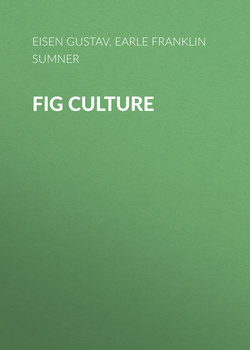Fig Culture

Реклама. ООО «ЛитРес», ИНН: 7719571260.
Оглавление
Earle Franklin Sumner. Fig Culture
EDIBLE FIGS: THEIR CULTURE AND CURING. By Gustav Eisen
NATURE AND STRUCTURE OF THE FLOWERS AND FRUIT OF THE FIG
CLASSIFICATION OF VARIETIES OF EDIBLE FIGS
VARIETIES OF FIGS FOUND USEFUL IN CALIFORNIA
CAPRIFICATION
CLIMATE SUITABLE FOR FIG CULTURE
FIGS FOR DRYING
FIGS FOR TABLE USE
FIGS FOR PRESERVING, CANNING, AND HOME CONSUMPTION
SOIL
PROPAGATION
SEEDLINGS
BUDDING AND GRAFTING
PLANTING
DOUBLE TREES
STANDARD TREES
PRUNING
DRYING AND CURING
PICKING
SULPHURING
DIPPING FRESH FIGS
DRYING ON TRAYS
DEGREE OF DRYNESS
SWEATING AND EQUALIZING
ARTIFICIAL DRYING
PACKING
DIPPING
ASSORTING
PULLING
PACKING
PRESSING
FIG CULTURE IN THE GULF STATES. By Frank S. Earle
PROPAGATION
SOIL AND LOCATION
CULTIVATION AND FERTILIZATION
INSECT ENEMIES AND DISEASES
FIG-TREE BORER
FIG-LEAF MITE
ROOT KNOT
FIG-LEAF RUST
FIG CERCOSPORA
DIE BACK
ROOT ROT
VARIETIES
List of figs recommended by American Pomological Society
USES
MARKETING FRESH FIGS
CANNING FACTORIES
Отрывок из книги
The edible figs cultivated in the United States both for eating fresh and for drying all belong to one species, Ficus carica. Of this species there are now described about 400 varieties which are sufficiently distinct to be considered by the student and the practical horticulturist. The intending planter should study the character of the varieties more closely than has hitherto been customary in this country, though his safest plan is, of course, to plant in quantity only such varieties as have proved valuable in his own locality, or where soil and climate are similar.
Before we consider these different varieties, a few remarks on the nature and structure of the fruit are necessary. The fig which we eat is really a receptacle, on the surface of which are situated the numerous flowers. But as this surface is concave, or curved inwardly, like the hollow of a closed hand, the flowers can not be seen except when the fig is cut. Then it becomes apparent that the chamber formed by the curved receptacle communicates with the outside by means of the “eye” at its apex. In some varieties the “eye” is almost closed, opening only when the fig has reached a certain age; in others it is so large that a pea could easily pass through. The flowers are always more or less fleshy, are generally imperfect, and do not much resemble the bright flowers of other fruit trees and plants in our gardens. There are four distinct kinds of fig flowers, but these are not always found in a single fig, in fact they are rarely all found together. They are designated as follows:
.....
Celeste, Blue (syn. Violette). – Small, ovate, turbinate; ribs few, but distinct, especially near apex; eye raised, rough; color dark, violet amber, without reddish blush; bloom confined to the neck; skin thin; pulp deep rose; meat amber; sweet, but lacking in flavor.
Dottato. – Medium ovate, pyriform; neck well set; stalk very short or none; ribs low; skin smooth; eye medium; skin thin, yellowish green; meat white; pulp yellowish amber, sometimes with violet flush. One of the best figs for drying; tree a strong grower, requiring moist, rich soil. Lately introduced into California.
.....